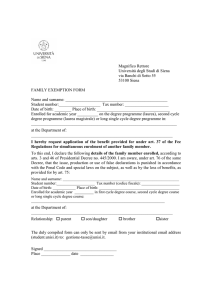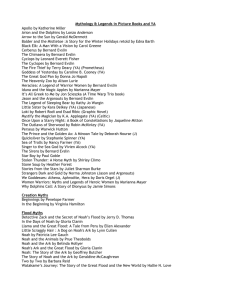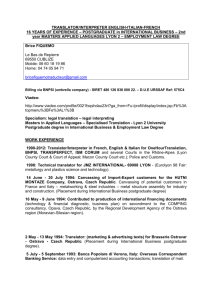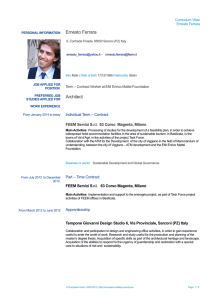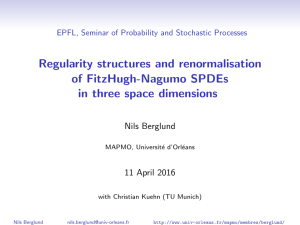The Effect of Inequalities on Partition Regularity of Linear Homogenous Equations
advertisement
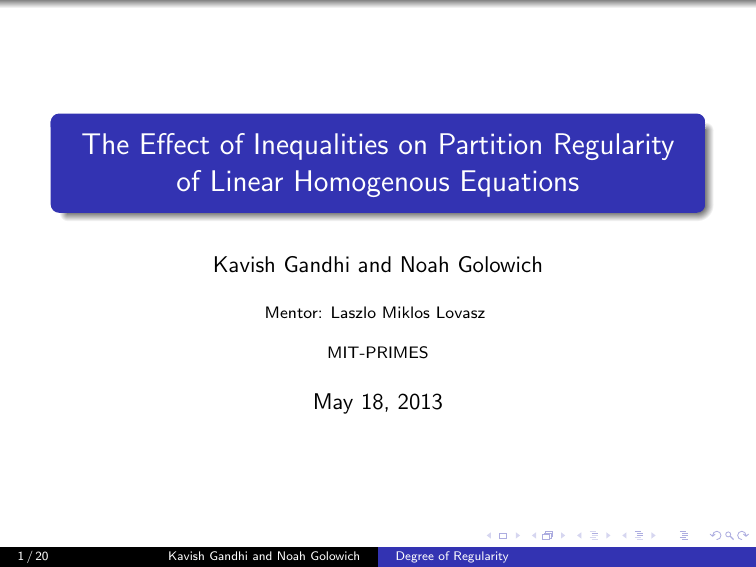
The Effect of Inequalities on Partition Regularity
of Linear Homogenous Equations
Kavish Gandhi and Noah Golowich
Mentor: Laszlo Miklos Lovasz
MIT-PRIMES
May 18, 2013
1 / 20
Kavish Gandhi and Noah Golowich
Degree of Regularity
A Simple Example of Ramsey Theory: Six People
Given 6 people, any 2 of whom are either friends or enemies
Property: There always exists a group of 3, all of whom are
friends or enemies with each other
Not true with 5 people, so 6 is the minimum number that
satisfies the property.
2 / 20
Kavish Gandhi and Noah Golowich
Degree of Regularity
Definitions
Definition
A linear homogenous equation is one of the form
c0 x0 + c1 x1 + c2 x2 + . . . + cn−1 xn−1 = 0, ci ∈ Z, xi ∈ N
3 / 20
Kavish Gandhi and Noah Golowich
Degree of Regularity
Definitions
Definition
A linear homogenous equation is one of the form
c0 x0 + c1 x1 + c2 x2 + . . . + cn−1 xn−1 = 0, ci ∈ Z, xi ∈ N
Definition
A linear homogenous equation of n variables is regular over the
integers if, for any finite coloring of the natural numbers, there
exist natural numbers x0 , x1 , . . . , xn−1 that:
satisfy the equation and
are the same color (are monochromatic).
Example: x0 + x1 − x2 = 0.
1 2 3 4 5 6 7 8 9 10 11 . . .
3 / 20
Kavish Gandhi and Noah Golowich
Degree of Regularity
Rado’s Theorem
Given a linear homogenous equation:
c0 x0 + c1 x1 + c2 x2 + . . . + cn−1 xn−1 = 0, ci ∈ Z, xi ∈ N
where c0 , c1 , . . . , cn−1 6= 0,
Rado’s theorem: states that this is regular if and only if some
subset of ci sum to 0.
3x0 + 4x1 − 5x2 + 2x3 = 0 is regular, for example.
We extend this by considering the effect on regularity of a finite
number of inequalities.
4 / 20
Kavish Gandhi and Noah Golowich
Degree of Regularity
Inequalities do not affect regularity
Theorem
For n, k, r ∈ N, and any r -coloring of the positive integers, there
exists a monochromatic solution of the form (x0 , · · · , xn−1 ) to
n−1
X
ci xi
= 0 : ci 6= 0
i=0
n−1
X
Aji xi
6= 0 : 1 ≤ j ≤ k
i=0
where a nonempty set of the ci sums to 0 and P
n−1
Aj0 x0 + · · · + Aj(n−1) xn−1 is not a multiple of i=0
ci xi for all
1 ≤ j ≤ k.
A nonempty set of the ci must sum toP0 by Rado’s Theorem.
n−1
Aj1 x1 + · · · + Ajn xn not a multiple of i=1
ci xi : if it were a
multiple, it would always be 0.
5 / 20
Kavish Gandhi and Noah Golowich
Degree of Regularity
Background Theorems for proof
Van der Waerden’s theorem: given any finite coloring of
the integers, guarantees a monochromatic arithmetic
progression of arbitrary length.
Example: 1 2 3 4 5 6 7 8 9 . . .
6 / 20
Kavish Gandhi and Noah Golowich
Degree of Regularity
Background Theorems for proof
Van der Waerden’s theorem: given any finite coloring of
the integers, guarantees a monochromatic arithmetic
progression of arbitrary length.
Example: 1 2 3 4 5 6 7 8 9 . . .
Extension of Van der Waerden Theorem: guarantees a
t-dimensional monochromatic arithmetic progression of
arbitrary length:
a + d1 l1 + d2 l2 + · · · + dt lt : 0 ≤ li ≤ L
6 / 20
Kavish Gandhi and Noah Golowich
Degree of Regularity
Background Theorems for proof
Van der Waerden’s theorem: given any finite coloring of
the integers, guarantees a monochromatic arithmetic
progression of arbitrary length.
Example: 1 2 3 4 5 6 7 8 9 . . .
Extension of Van der Waerden Theorem: guarantees a
t-dimensional monochromatic arithmetic progression of
arbitrary length:
a + d1 l1 + d2 l2 + · · · + dt lt : 0 ≤ li ≤ L
a = 1, t = 2, d1 = 2(horizontal), d2 = 3(vertical), L = 3:
1 3 5 7
4 6 8 10
7 9 11 13
10 12 14 16
6 / 20
Kavish Gandhi and Noah Golowich
Degree of Regularity
Strengthening Extended Van der Waerden’s
Important lemma to prove theorem:
Lemma
For all L ∈ N, a r -coloring of the natural numbers,
s1 , s2 , . . . , st ≥ 1 and inequalities:
hj1 d1 + hj2 d2 + · · · + hjt dt 6= 0
there exists a, d1 , d2 , . . . , dt > 0 such that
(
)
t
X
a+
li di : 0 ≤ li ≤ L ∪ {si di : 1 ≤ i ≤ t}
i=1
is monochromatic.
7 / 20
Kavish Gandhi and Noah Golowich
Degree of Regularity
Strengthening Extended Van der Waerden’s
Important lemma to prove theorem:
Lemma
For all L ∈ N, a r -coloring of the natural numbers,
s1 , s2 , . . . , st ≥ 1 and inequalities:
hj1 d1 + hj2 d2 + · · · + hjt dt 6= 0
there exists a, d1 , d2 , . . . , dt > 0 such that
(
)
t
X
a+
li di : 0 ≤ li ≤ L ∪ {si di : 1 ≤ i ≤ t}
i=1
is monochromatic.
2 main ideas: Use extended Van der Waerden’s Theorem, then
1 Add in inequalities on d .
i
2 Add in {s d } that must be monochromatic.
i i
7 / 20
Kavish Gandhi and Noah Golowich
Degree of Regularity
Using lemmas
P
Goal is to find monochromatic xi that satisfy
ci xi = 0 and
P
Aji xi 6= 0.
Prove that there exist numbers of a certain form that are
monochromatic.
Prove that any numbers of this form satisfy the equation and
inequalities.
The numbers of a “certain form” is the form we proved in the
lemma:
(
)
t
X
a+
li di : 0 ≤ li ≤ L ∪ {si di : 1 ≤ i ≤ t}
i=1
↓ . . . . . . . . ↓
{x0 , x1 , x2 , . . . , xn−t−1 }————{xn−t , xn−t+1 , . . . , xn−1 }
With the parametrization shown above, it is simple to prove that
numbers of this form satisfy the equation and inequalities.
8 / 20
Kavish Gandhi and Noah Golowich
Degree of Regularity
Discussion
Initial problem: many of the xi can be set equal in Rado’s
Theorem, allowing a partially degenerate solution.
9 / 20
Kavish Gandhi and Noah Golowich
Degree of Regularity
Discussion
Initial problem: many of the xi can be set equal in Rado’s
Theorem, allowing a partially degenerate solution.
We showed that we can make a solution less degenerate but
still preserve regularity
9 / 20
Kavish Gandhi and Noah Golowich
Degree of Regularity
Discussion
Initial problem: many of the xi can be set equal in Rado’s
Theorem, allowing a partially degenerate solution.
We showed that we can make a solution less degenerate but
still preserve regularity
Example: x0 − x1 + 2x2 + 4x3 = 0 is regular by Rado’s Theorem.
1 2 3 4 5 6 7 8 9 10
x0 = x2 = x3 = 1, x1 = 7 is a monochromatic solution.
Say we want x2 − x3 6= 0, though.
So, add a finite number of inequalities.
Conclusion: Regularity does not change with inequalities.
9 / 20
Kavish Gandhi and Noah Golowich
Degree of Regularity
Regularity
Definition
A linear homogenous equation is r -regular over N if, for every
coloring of N with at most r colors, there exist monochromatic
x0 , x1 , . . . , xn−1 that satisfy the equation.
10 / 20
Kavish Gandhi and Noah Golowich
Degree of Regularity
Regularity
Definition
A linear homogenous equation is r -regular over N if, for every
coloring of N with at most r colors, there exist monochromatic
x0 , x1 , . . . , xn−1 that satisfy the equation.
Definition
The degree of regularity (DoR) of a linear homogenous equation
is the largest positive integer k such that it is k-regular.
10 / 20
Kavish Gandhi and Noah Golowich
Degree of Regularity
Regularity
Definition
A linear homogenous equation is r -regular over N if, for every
coloring of N with at most r colors, there exist monochromatic
x0 , x1 , . . . , xn−1 that satisfy the equation.
Definition
The degree of regularity (DoR) of a linear homogenous equation
is the largest positive integer k such that it is k-regular.
Example:
−7x0 + 6x1 + 4x2 = 0 is 2-regular, but not 3-regular, so its
DoR = 2
10 / 20
Kavish Gandhi and Noah Golowich
Degree of Regularity
Goals
We proved that inequalities do not affect regularity.
What about non-regular but r -regular equations, for a given r ?
11 / 20
Kavish Gandhi and Noah Golowich
Degree of Regularity
Degree of Regularity
Family of equations:
p−1
X
i=1
2i
xi =
2i − 1
−1 +
p−1
X
i=1
2i
2i − 1
!
x0
Known result: for each value of p, the equation is known to have a
degree of regularity of p − 1 (Alexeev & Tsimerman, 2009),
verifying a conjecture of Rado.
We begin with small values of p.
12 / 20
Kavish Gandhi and Noah Golowich
Degree of Regularity
−7x0 + 6x1 + 4x2 = 0
For p = 3, the equation simplifies to −7x0 + 6x1 + 4x2 = 0.
Degree of regularity of 2.
13 / 20
Kavish Gandhi and Noah Golowich
Degree of Regularity
−7x0 + 6x1 + 4x2 = 0
For p = 3, the equation simplifies to −7x0 + 6x1 + 4x2 = 0.
Degree of regularity of 2.
Theorem
Given a 2-coloring of the integers, the equation
−7x0 + 6x1 + 4x2 = 0, and a finite number l of inequalities:
Aj0 x0 + Aj1 x1 + Aj2 x2 6= 0, 1 ≤ j ≤ l
none of which is a multiple of −7x0 + 6x1 + 4x2 = 0, we can
always find a monochromatic solution (x0 , x1 , x2 ).
13 / 20
Kavish Gandhi and Noah Golowich
Degree of Regularity
p=3
Use parametrizations!
(2n + 4k, n + 4k, 2n + k) is always a solution to
−7x0 + 6x1 + 4x2 = 0.
We prove that there exist infinitely many pairs (n, k) that
make the triplet monochromatic under any 2-coloring:
Only a bounded number do not satisfy the inequalities
14 / 20
Kavish Gandhi and Noah Golowich
Degree of Regularity
p=3
Use parametrizations!
(2n + 4k, n + 4k, 2n + k) is always a solution to
−7x0 + 6x1 + 4x2 = 0.
We prove that there exist infinitely many pairs (n, k) that
make the triplet monochromatic under any 2-coloring:
Only a bounded number do not satisfy the inequalities
Pick monochromatic AP: 4m, 4m+4d, 4m+8d, . . . , 4m + 4Ld
If there are no triplets of the desired form, these are blue:
m+8d, m+16d, . . . , m + 64d , m + 72d, . . . m + 4Ld
2m+16d , 2m+32d, 2m + 48d, 2m + 64d , . . . , 2m + 4Lk
But now set m = n, k = 16d, and we are done!
14 / 20
Kavish Gandhi and Noah Golowich
Degree of Regularity
p=4
Theorem
Given a 3-coloring of the integers, the equation
3
X
i=1
2i
xi =
2i − 1
−1 +
3
X
i=1
2i
2i − 1
!
x0
and a finite number l of inequalities: none of which is a multiple of
the equation, we can always find a monochromatic solution
(x0 , x1 , x2 , x3 ).
To prove this, we again use parametrizations.
(2m + 4n + 8k, m + 4n + 8k, 2m + n + 8k, 2m + 4n + k) is
always a solution to this equation.
Proof to find a monochromatic quadruplet is somewhat
similar.
15 / 20
Kavish Gandhi and Noah Golowich
Degree of Regularity
Conditions on Regularity
Also explored DoR of various linear homogenous equations
Idea: generalize the methods used with the family of equations
from before to general linear homogenous equations
16 / 20
Kavish Gandhi and Noah Golowich
Degree of Regularity
Conditions on Regularity
Also explored DoR of various linear homogenous equations
Idea: generalize the methods used with the family of equations
from before to general linear homogenous equations
First considered a0 x0 + a1 x1 + a2 x2 = 0 in terms of its
2-regularity
Used a similar approach as with 6x0 + 4x1 − 7x2 = 0
16 / 20
Kavish Gandhi and Noah Golowich
Degree of Regularity
b22 b3 = b12 b0
Idea: expand on parametrizations to find a stronger condition on
2-regularity.
17 / 20
Kavish Gandhi and Noah Golowich
Degree of Regularity
b22 b3 = b12 b0
Idea: expand on parametrizations to find a stronger condition on
2-regularity.
Theorem
If, for some parametrization (b0 y0 + b1 y1 , b0 y0 + b2 y1 , b3 y0 + b2 y1 )
b0 6= b3 , b1 6= b2
a0 b0 + a1 b0 + a2 b3 = 0, a0 b1 + a1 b2 + a2 b2 = 0
b02 b1 = b32 b2 or b12 b0 = b22 b3
then the equation a0 x0 + a1 x1 + a2 x2 = 0 is 2-regular.
Furthermore, all 3 integers in the triple are not equal.
17 / 20
Kavish Gandhi and Noah Golowich
Degree of Regularity
b22 b3 = b12 b0
Idea: expand on parametrizations to find a stronger condition on
2-regularity.
Theorem
If, for some parametrization (b0 y0 + b1 y1 , b0 y0 + b2 y1 , b3 y0 + b2 y1 )
b0 6= b3 , b1 6= b2
a0 b0 + a1 b0 + a2 b3 = 0, a0 b1 + a1 b2 + a2 b2 = 0
b02 b1 = b32 b2 or b12 b0 = b22 b3
then the equation a0 x0 + a1 x1 + a2 x2 = 0 is 2-regular.
Furthermore, all 3 integers in the triple are not equal.
−7x0 + 6x1 + 4x2 = 0 is a special case of this where
b0 = 2, b1 = 1, b2 = 4, b3 = 1.
17 / 20
Kavish Gandhi and Noah Golowich
Degree of Regularity
Tying this in with Inequalities
We can also link this with inequalities
18 / 20
Kavish Gandhi and Noah Golowich
Degree of Regularity
Tying this in with Inequalities
We can also link this with inequalities
How can we prove this?
Prove that there exist an arbitrarily large amount of triples
that satisfy the lemma previously mentioned
Show that a bounded number do not satisfy the inequalities
18 / 20
Kavish Gandhi and Noah Golowich
Degree of Regularity
Tying this in with Inequalities
We can also link this with inequalities
How can we prove this?
Prove that there exist an arbitrarily large amount of triples
that satisfy the lemma previously mentioned
Show that a bounded number do not satisfy the inequalities
Example: −7x0 + 6x1 + 4x2 = 0
m + 8d, . . . , m + 64d , m + 72d, . . . , m+128d
2m+16d , 2m+32d , 2m + 48d, 2m + 64d , . . . , 2m+128d
If one triplet does not satisfy the inequalities, pick the other
18 / 20
Kavish Gandhi and Noah Golowich
Degree of Regularity
Future Research
Generalize the family of equations to any number of variables
Analyze how inequalities affect the DoR of other linear
homogenous equations
What are the conditions on 3-regularity for an equation
a0 x0 + a1 x1 + . . . + an−1 xn−1 = 0? 4-regularity? k-regularity?
Generalize the idea that inequalities do not affect regularity to
systems of linear homogenous equations
Is a regular equation still regular if the xi must be relatively
prime?
19 / 20
Kavish Gandhi and Noah Golowich
Degree of Regularity
Acknowledgements
Many thanks to:
Laszlo Miklos Lovasz, our mentor
Jacob Fox
Tanya Khovanova
Our awesome parents
MIT PRIMES
20 / 20
Kavish Gandhi and Noah Golowich
Degree of Regularity
